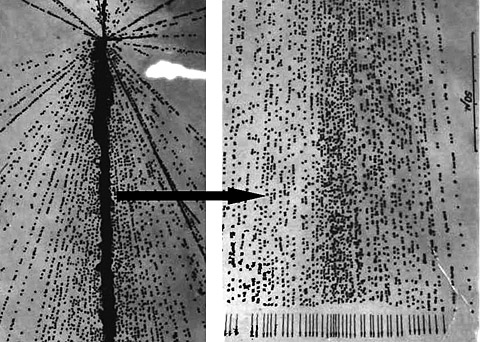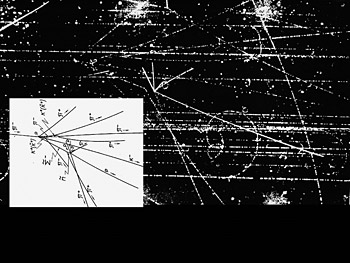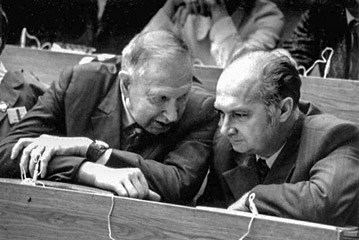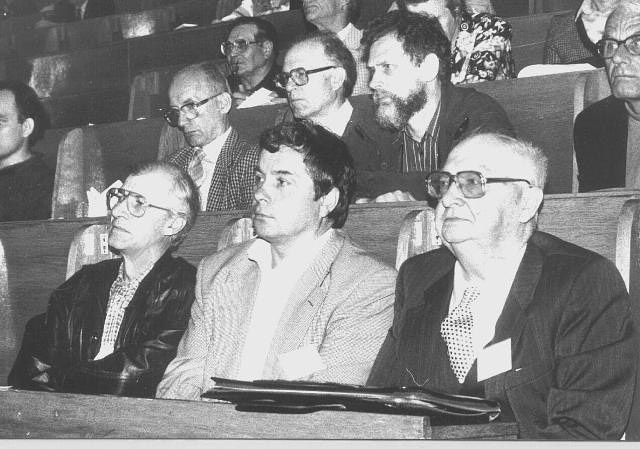
Electronic english version since 2022 |
The newspaper was founded in November 1957
| |
In the laboratories of the Institute
From the first observations of cosmic rays
to the physics of relativistic nuclei
Starts in No. 7 from 21 February
In Moscow, the technological and analytical foundations of the nuclear emulsion technique for relativistic particles were mastered that allowed to carry out fundamental observations of relativistic particles in high-altitude irradiations. A projective photograph of the interaction of a nucleus with gigantic energy in a nuclear emulsion that resulted in a tremendous multiplicity of secondary particles is shown in the Figure. The traces in the stream of fragments can be completely identified. The completeness and reliability of observing traces of nuclear reactions, the unique resolution and flexibility of application of this technique remain unsurpassed to this day.
 |
| Macro photograph of the interaction of a cosmic-origin nucleus in a nuclear emulsion. FIAN, early 1950s (provided by G.I.Orlova) |
The production of a domestic thick-layer nuclear emulsion for the launch of the synchrophasotron became the starting point for obtaining the first physical results. It is worth recalling that this event raised doubts abroad. Thus, Nobel prize winner S.Powell that discovered the π-meson, united the consent of physicists of the Lebedev Physical Institute to the republication of his fundamental research in the USSR with the provision of photographic plates that objectively confirmed the success of the accelerator. Photographs of characteristic interactions were included in the Russian edition. Analysis of the first irradiations allowed an overview of the topology of nuclear stars and angular measurements of the emerging tracks. To this day, the observations of the complete destruction of target nuclei and the coherent development of mesons in events not accompanied by traces of target fragmentation remain unique. Irradiation of emulsion stacks continued in the 1960s in relation to elastic scattering as a source of information about the structure of protons.
The discovery of the decay of strange particles in nuclear emulsions irradiated in the stratosphere resulted in the construction of bubble chambers that covered many orders of magnitude larger detection volumes in a magnetic field. The Nobel lecture of L. Alvarez allows one to learn about the level of research and the scope of innovation in the United States in this area. The solution for LHE was the construction of a 40-centimeter bubble chamber based on liquefied propane. To irradiate it, an external beam of π-- mesons with a momentum of 8.3 GeV/c was generated.
 |
| Photograph in a bubble chamber of the development and decay of an anti-sigma-minus hyperon into an antineutron, manifested in an annihilation star and a π+ meson (provided by A.A.Kuznetsov) |
A fundamental factor in the success was the involvement of V.I.Veksler in the synchrophasotron project of two groups of graduates of the Faculty of Physics of Moscow State University. Responding to skeptics, he insisted: "The youth will not let me down!" Among the co-authors of the first publications we meet the names of young scientists: E.N.Kladnitskaya, L.N.Strunov, E.N.Tsyganov, V.A.Belyakov, V.A.Nikitin, A.V.Nikitin. The global level to which JINR has reached contributed to the choice of Dubna in 1964 to host the XII International (Rochester) Conference on High Energy Physics.
To develop particle physics up to antiprotons, in 1965, the concept of a synchrophasotron was proposed as a source of secondary particles generated on its internal targets. First of all, an increase in the intensity of circulating protons by three to four orders of magnitude was required that meant the development of a new linear accelerator for injection. A project to create a powerful concrete protection over the ring was suggested. Then it was necessary to develop channels for separated beams of secondary particles, including electrostatic separators of K-mesons and antiprotons that were positioned in the attached building 1B. A neutron channel with wiring through 1B into the body of the hydrogen chamber was implemented during the fragmentation of relativistic deuterons.
The proposed paradigm turned out to be a powerful stimulus for the development of experimental techniques at LHE that made experiments in relativistic nuclear physics possible in the 1970s. The focus of efforts was the development of a two-meter propane, xenon, one-meter hydrogen and streamer chambers. Techniques of electronic experiments were developed: Cherenkov gas counters, organic plastic scintillators, multiwire spark and proportional chambers, Cherenkov total absorption detectors, nanosecond electronics, interface with computers. It required the development of cryogenic targets, nuclear electronics and interface with electronic computers that were just beginning to appear. Surely, this list is not complete and it is worth referring to the JINR Annual Reports of that period.
Along this path, there were not only successes, but also disappointments. First of all, it was not possible to obtain the expected intensity of the separated beams. At the same time, the resources and experience of LHE scientists and specialists were required for prestigious experiments at the Institute of High Energy Physics (Protvino), where in 1967, the U-70 hard-focusing synchrotron with record proton energy was launched for the 50th anniversary of the Great October Socialist Revolution. Having appeared on the new frontier of high-energy physics, this accelerator attracted the attention of not only physicists of the Soviet Union and JINR Member States, but also CERN and the USA.
The difficulties were aggravated by the untimely death in 1966 of V.I.Veksler, a charismatic personality that knew how to take responsibility and to meet not only scientific and technological, but also organizational issues of unprecedented complexity. I.V.Chuvilo ("Weksler's right hand") headed the Institute of Experimental Physics, where the U-10 hard-focusing synchrotron that served as a prototype of the Serpukhov accelerator U-70, was already operating. Proposals arose about the complete orientation of LHE to work at IHEP with corresponding decisions regarding the synchrophasotron and the main part of the LHE team concerning it.
 |
| M.A.Markov and A.M.Baldin. Photo by Yu.A.Tumanov |
Having started his work at the Lebedev Physical Institute on the physical substantiation of the synchrophasotron, A.M.Baldin by that time had received recognition as a theorist in the field of physics of electromagnetic interactions of hadrons and nuclei. He collaborated with LHE in the search for electromagnetic decays of vector mesons, culminating in the first observation of the decay φ → e+e-. It is no coincidence that this area became the topic of the first international seminar on problems of high energy physics, held in September 1969, headed by A.M.Baldin. Over time, the topics of this forum expanded to include multiple processes, extreme nuclear fragmentation and quantum chromodynamics. The seminar acquired the status of a major conference with significant international and Russian participation.
The starting points for A.M.Baldin in the scientific area he formulated and called "Relativistic Nuclear Physics" were the data that had just appeared at IHEP, demonstrating the scale-invariant behavior of the inclusive spectra of produced hadrons. On the other hand, research into deep inelastic electron scattering at Stanford (USA) pointed to a point-like (or parton) structure of nucleons. This picture was also supported by the validity of the Matveev-Muradyan-Tavkhelidze quark counting rules for elastic scattering of hadrons with large momentum transfers.
A.M.Baldin proposed to extend the hypothesis of scale invariance to the collision of relativistic nuclei as a consequence of the point mechanism of interaction of nuclear nucleons. Testing the hypothesis required studying the production of pions in the area of extreme fragmentation that at an energy of about 3 GeV per nucleon required going beyond the limits of nucleon-nucleon kinematics. A.M.Baldin recalled a brief conversation with R.Feynman during a conference of the American Institute of Physics in 1971, that sounded something like this: "I know when the Feynman variable can be greater than one." Answer: "No, it's impossible... (pause)..., well, of course, in the nuclei!"
In the 1970-1980s, exhaustive measurements of the inclusive spectra of cumulative hadrons, including antiprotons, baryon fragments, were carried out in the group of V.S.Stavinsky at LHE and G.A.Leksin at the Institute of Theoretical and Experimental Physics in Moscow. They constitute a unique layer of the physical picture of parton degrees of freedom in nuclear matter and provided the basis for the development of ideas about the self-similar behavior of multiple particle production in collisions of hadrons and nuclei based on data from bubble chambers headed by A.M.Baldin.
The acceleration of deuterons at the synchrophasotron that resulted in the discovery of the cumulative effect, became a prerequisite for the start of new experiments, headed by L.N.Strunov and L.S.Azhgirey to study the wave function of the deuteron at small internucleon distances. The world level in the research of spin aspects in the structure of the deuteron was achieved thanks to the development of a source of polarized deuterons in the 1980s, headed by Yu.K.Pilipenko. On its basis, experiments were carried out in the 1990s with a polarized proton target delivered from DAPhNIA (Saclay).
Extracted beams of light nuclei obtained from electron beam and laser sources allowed to implement survey investigations using the nuclear emulsion technique in a two-meter propane chamber, as well as in a one-meter bubble and streamer chambers. All the topics covered deserve their own retrospective reviews.
In practical terms, experiments in relativistic nuclear physics carried out in the 1970s provided a vital impetus for the modernization and regular operation of the synchrophasotron. Headed by L.P.Zinoviev, a new linear injector was put into operation and headed by I.B.Issinsky, a slow output of a beam of four orders of magnitude greater intensity than that of the internal beam in the 1960s was carried out. Thus, protection over the accelerator has lost its relevance. The Minister of Medium Engineering of the USSR E.P. Slavsky supported the initiative of A.M.Baldin to construct a new 205th building of extracted beams that was carried out under the supervision of L.G.Makarov (later, the "locomotive" of the Nuclotron project). According to D.V.Skobeltsyn, having a 20-year resource, the huge vacuum volume of the synchrophasotron chamber was maintained in working condition until its operation was completed in the late 1990s. Thus, the targeted improvement of the accelerator, the extensive implementation of experiments on it, the development of conclusions and generalizations mutually pushed each other, attracting an ever-wider circle of users. It seems that in this close relationship lies the secret of the development of relativistic nuclear physics, its entry to the world level and the development of prerequisites for the construction of the Nuclotron in the 1980s.

A.D.Kovalenko, A.I.Malakhov and A.M.Baldin at a meeting of the International Seminar
on Problems of High Energy Physics (1990s). Photo by Yu.A.Tumanov
This scientific and historical lesson from V.I.Veksler and A.M.Baldin, their predecessors, associates and followers remains relevant. Participation in experiments in relativistic nuclear physics at the leading accelerator centres in the world was developed on this platform. A retrospective look at the history of VBLHEP is instructive to this day, as it allows us to apply and extrapolate a kind of arrow of time. Facsimile of almost forgotten articles and memories accumulated on the site of the BECQUEREL emulsion experiment, following JINR publications and on the Internet, they allow you to feel the inspiring atmosphere of the first steps in this area and to trace the scientific growth of VBLHEP in facts.
Since VBLHEP is the focus of the essay, the author allowed himself not to dwell on foreign stages, starting from the discovery of relativistic nuclei in the stratosphere in 1949. Among them was the development of research with relativistic heavy ions at Bevalak at the Lawrence Berkeley Laboratory (USA) in the 1970s. Another major step is the physics of relativistic few-nucleon systems, that first drew up an agenda on weakly focusing SATURN (CEA, Saclay, France) that continued on the hard-focusing SATURN-2 (DAPhNIA-CEA Laboratory). A retrospective review of the progress of these laboratories would be instructive. Their achievements are presented and noted in the proceedings of the International Seminars that turned into a recognized international conference in the 1970s and 1980s.
Our website becquerel.jinr.ru, focused mainly on the ongoing BECCEREL experiment, can serve as a starting point into the Russian history of high-energy physics. Historical materials accumulate in the background to prevent loss or oblivion. Otherwise, there is a risk of forgetting about the impressive development of microworld physics, more than our contemporaries often know. Since direct citation is difficult here, the author is ready to help in finding both cited materials and many others and is also interested in expanding it. For obvious historical reasons, most of the rarities on the BECQUEREL website are presented in Russian and older publications are added as they are discovered. A collection of abstracts from the 1964 Dubna conference has recently been added to the papers/books section. Through the same section, chapters of annual reports of LHE JINR since 1965 have been available. A good source for independent searches is the INSPIRE database that contains materials from International conferences on high energy physics since the 1950s.
The author is grateful to Professor A.I.Malakhov for the invitation to present reports on the occasion of the 65th anniversary of the launch of the synchrophasotron in 2022 and the opening of the XXV International Seminar on High Energy Physics ("Baldinskaya Autumn - 2023"). I.G.Zarubina's work on the BECQUEREL website that started on her initiative in 2004 and is carried out to the present day, deserves sincere gratitude.
Pavel ZARUBIN,
Head of Sector of Processing Thick-Layer Emulsions of VBLHEP